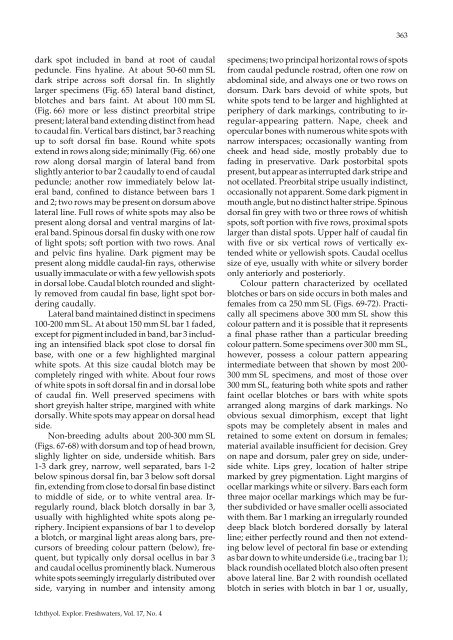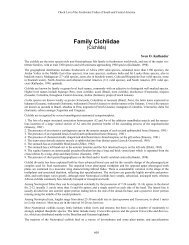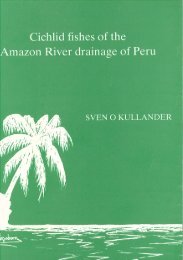Open Access PDF - Sven Kullander
Open Access PDF - Sven Kullander
Open Access PDF - Sven Kullander
Create successful ePaper yourself
Turn your PDF publications into a flip-book with our unique Google optimized e-Paper software.
dark spot included in band at root of caudal<br />
peduncle. Fins hyaline. At about 50-60 mm SL<br />
dark stripe across soft dorsal fin. In slightly<br />
larger specimens (Fig. 65) lateral band distinct,<br />
blotches and bars faint. At about 100 mm SL<br />
(Fig. 66) more or less distinct preorbital stripe<br />
present; lateral band extending distinct from head<br />
to caudal fin. Vertical bars distinct, bar 3 reaching<br />
up to soft dorsal fin base. Round white spots<br />
extend in rows along side; minimally (Fig. 66) one<br />
row along dorsal margin of lateral band from<br />
slightly anterior to bar 2 caudally to end of caudal<br />
peduncle; another row immediately below lateral<br />
band, confined to distance between bars 1<br />
and 2; two rows may be present on dorsum above<br />
lateral line. Full rows of white spots may also be<br />
present along dorsal and ventral margins of lateral<br />
band. Spinous dorsal fin dusky with one row<br />
of light spots; soft portion with two rows. Anal<br />
and pelvic fins hyaline. Dark pigment may be<br />
present along middle caudal-fin rays, otherwise<br />
usually immaculate or with a few yellowish spots<br />
in dorsal lobe. Caudal blotch rounded and slightly<br />
removed from caudal fin base, light spot bordering<br />
caudally.<br />
Lateral band maintained distinct in specimens<br />
100-200 mm SL. At about 150 mm SL bar 1 faded,<br />
except for pigment included in band, bar 3 including<br />
an intensified black spot close to dorsal fin<br />
base, with one or a few highlighted marginal<br />
white spots. At this size caudal blotch may be<br />
completely ringed with white. About four rows<br />
of white spots in soft dorsal fin and in dorsal lobe<br />
of caudal fin. Well preserved specimens with<br />
short greyish halter stripe, margined with white<br />
dorsally. White spots may appear on dorsal head<br />
side.<br />
Non-breeding adults about 200-300 mm SL<br />
(Figs. 67-68) with dorsum and top of head brown,<br />
slighly lighter on side, underside whitish. Bars<br />
1-3 dark grey, narrow, well separated, bars 1-2<br />
below spinous dorsal fin, bar 3 below soft dorsal<br />
fin, extending from close to dorsal fin base distinct<br />
to middle of side, or to white ventral area. Irregularly<br />
round, black blotch dorsally in bar 3,<br />
usually with highlighted white spots along periphery.<br />
Incipient expansions of bar 1 to develop<br />
a blotch, or marginal light areas along bars, precursors<br />
of breeding colour pattern (below), frequent,<br />
but typically only dorsal ocellus in bar 3<br />
and caudal ocellus prominently black. Numerous<br />
white spots seemingly irregularly distributed over<br />
side, varying in number and intensity among<br />
Ichthyol. Explor. Freshwaters, Vol. 17, No. 4<br />
363<br />
specimens; two principal horizontal rows of spots<br />
from caudal peduncle rostrad, often one row on<br />
abdominal side, and always one or two rows on<br />
dorsum. Dark bars devoid of white spots, but<br />
white spots tend to be larger and highlighted at<br />
periphery of dark markings, contributing to irregular-appearing<br />
pattern. Nape, cheek and<br />
opercular bones with numerous white spots with<br />
narrow interspaces; occasionally wanting from<br />
cheek and head side, mostly probably due to<br />
fading in preservative. Dark postorbital spots<br />
present, but appear as interrupted dark stripe and<br />
not ocellated. Preorbital stripe usually indistinct,<br />
occasionally not apparent. Some dark pigment in<br />
mouth angle, but no distinct halter stripe. Spinous<br />
dorsal fin grey with two or three rows of whitish<br />
spots, soft portion with five rows, proximal spots<br />
larger than distal spots. Upper half of caudal fin<br />
with five or six vertical rows of vertically extended<br />
white or yellowish spots. Caudal ocellus<br />
size of eye, usually with white or silvery border<br />
only anteriorly and posteriorly.<br />
Colour pattern characterized by ocellated<br />
blotches or bars on side occurs in both males and<br />
females from ca 250 mm SL (Figs. 69-72). Practically<br />
all specimens above 300 mm SL show this<br />
colour pattern and it is possible that it represents<br />
a final phase rather than a particular breeding<br />
colour pattern. Some specimens over 300 mm SL,<br />
however, possess a colour pattern appearing<br />
intermediate between that shown by most 200-<br />
300 mm SL specimens, and most of those over<br />
300 mm SL, featuring both white spots and rather<br />
faint ocellar blotches or bars with white spots<br />
arranged along margins of dark markings. No<br />
obvious sexual dimorphism, except that light<br />
spots may be completely absent in males and<br />
retained to some extent on dorsum in females;<br />
material available insufficient for decision. Grey<br />
on nape and dorsum, paler grey on side, underside<br />
white. Lips grey, location of halter stripe<br />
marked by grey pigmentation. Light margins of<br />
ocellar markings white or silvery. Bars each form<br />
three major ocellar markings which may be further<br />
subdivided or have smaller ocelli associated<br />
with them. Bar 1 marking an irregularly rounded<br />
deep black blotch bordered dorsally by lateral<br />
line; either perfectly round and then not extending<br />
below level of pectoral fin base or extending<br />
as bar down to white underside (i.e., tracing bar 1);<br />
black roundish ocellated blotch also often present<br />
above lateral line. Bar 2 with roundish ocellated<br />
blotch in series with blotch in bar 1 or, usually,




